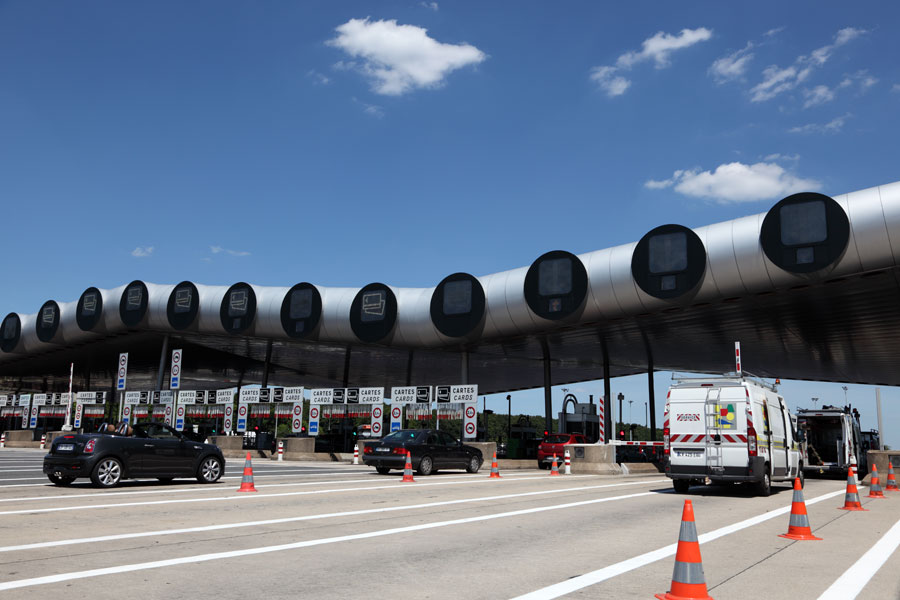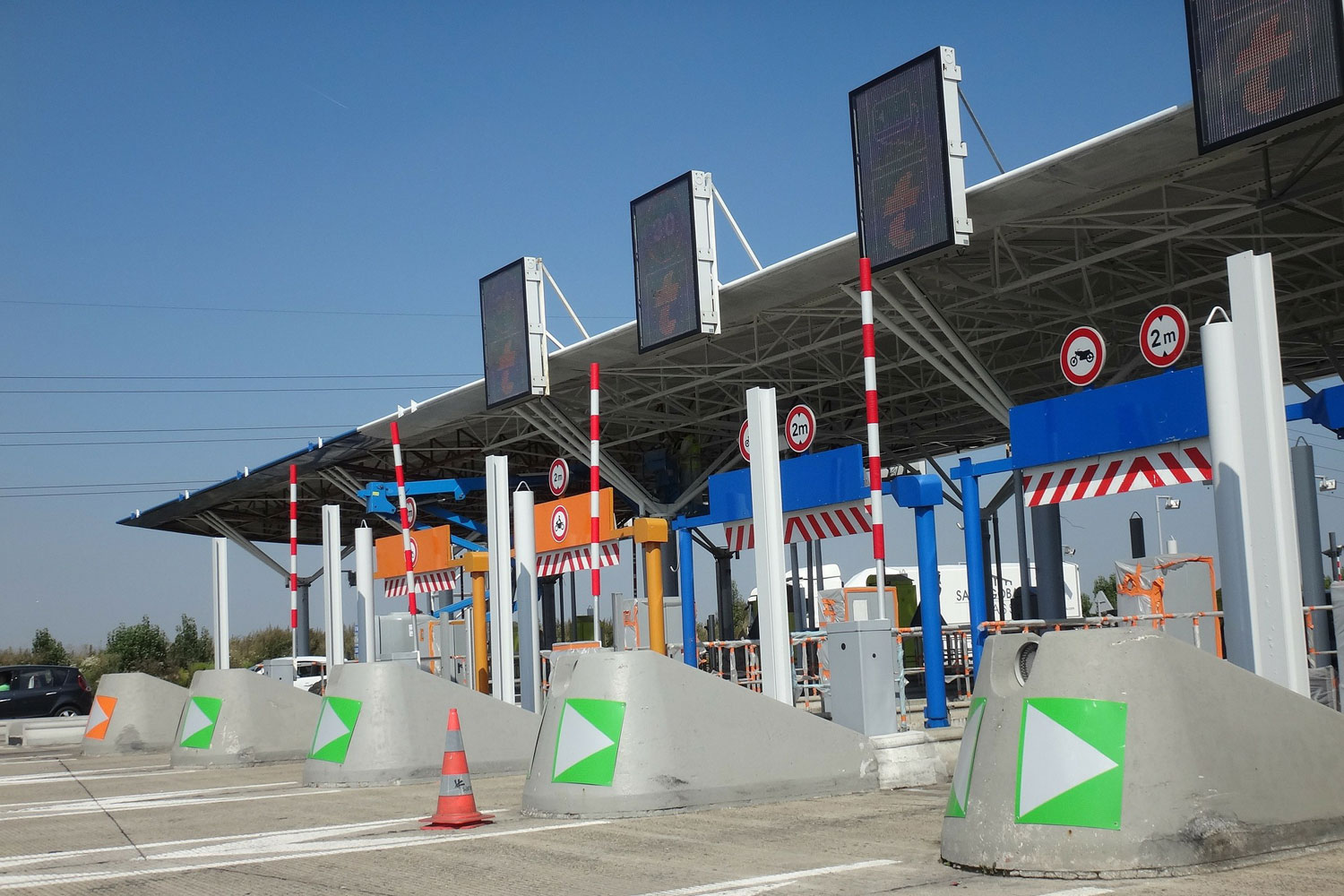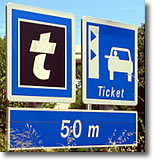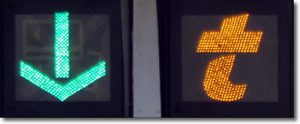French autoroute tolls: we tell you exactly how they work
Read our 7 tips to prepare, pay for and pass through French autoroute tolls in a motorhome or campervan without delays, hiccups or stress…

A toll (péage) on a French autoroute
Methods for extracting fees from motorists to use the road network seem to be different in just about every country in the world. Even within the European Union there are a variety of differing systems. Some have no road tolls but motorists pay an annual licence fee, others have no annual fee but charge for the use of certain roads, and some have a mixture of both!
In France, there’s no annual fee and motorists pay only when they use the autoroutes (some of you may call them motorways/highways/freeways/multi-carriageway roads/turnpikes). They are the somewhat dull but fast roads of France where big distances can be covered in the quickest possible time. The speed limit is 130 km/h (or 110 km/h if it’s raining) and they are typically between two and four carriageways in each direction. Toll fees vary greatly across the autoroutes, so before planning your final route, it’s best to look at your journey on a website like The ASFA (French Motorway Companies Association) which will show any toll fees in your path.
It pays to avoid toll roads when you can (read our blog about how far you should go here). But if you do need to cover a big distance in the shortest possible time they are your best option. Other than a few north/south routes and the odd spot where they pass a very big city such as Paris or Lyon, the autoroutes tend to flow very well and traffic jams or grid locks (“bouchons” in French – the same word for a cork!) are rare. You might encounter delays at weekends on routes between Paris and the south coast during July and August, and on the routes that lead up to the Alps during school holidays in the ski season. Otherwise the autoroutes are rarely oversubscribed. Ironically, most delays are caused by queues to get through the toll stations!

Passing through a French toll. You can see how many options there are – take the one with high clearance!
To ensure you are not the cause of an autoroute “bouchon” by being the ill-informed tourist who blocks the toll station (péage) while they work out what to do, we answer the most common questions, so that you can be prepared for toll stations:
1. How do they work and what do I do when I encounter an autoroute toll station?
Firstly, we’d just like to say don’t worry about the tolls, it is really hard to get them wrong! The toll payment system is very simple in France and there are no tricky requirements or advance actions required to trip you up. You just pay for the section of road that is toll charging and you cannot overlook it because there are barriers across the road which won’t let you pass until you pay. Most autoroutes are toll paying roads so it is reasonable to assume you will be asked to pay if you use an autoroute.
There are two types of toll barrier that you will encounter, one where you enter the toll charging section (where you typically take a ticket) and one when you leave it (where you will be asked to pay). There are also some sections of autoroute without the requirement to take a ticket and these will prompt you to pay a fixed price when you enter or exit the chargeable zone. Sometimes the toll barriers are at the entry/exit to the autoroute and sometimes they are across all lanes of the autoroute. Either way you cannot fail to go through them or to spot them as there are very visible warnings on the approach to both types.

Take a ticket sign on a French autoroute
When you get to the toll station simply either take a ticket or pay depending on which it prompts you to do. When you take a ticket, remember to keep it somewhere very safe and easy to find as you will need it to exit and pay later. If you lose the ticket you will be asked to pay for the use of the whole toll charging section because you cannot prove where you joined the autoroute. When you encounter a toll paying station, if it asks for a ticket, just insert your ticket into the relevant slot and it will then show you how much to pay. Once you have paid the barrier will lift and you can pass.
2. Do I need to pre-pay for tolls or buy a tag?
There is a tag system in France for autoroute tolls, but it’s not compulsory and indeed it is only available to EU residents on a subscription basis with a monthly charge. If you plan to use the autoroutes here regularly it’s worth buying as there are special lanes for tag holders (marked with a ‘t’ – see the photos above and below), making it fast and easy to pass through the toll barriers. A number of our regular UK-based clients have obtained the tag via Sanef tolling (the French autoroute operator) .
3. If I don’t have a tag how do I pay?
You can pay for tolls by credit card or cash. Most tolls are now automated and unmanned but some of the really busy autoroutes do still have manned booths. Where available, booths with a picture of a person in a cap above the lane will be manned so head for one of those if you prefer to deal with a human being. The automatic tolls will show instructions in French by default, but it’s very obvious what to do and if you can’t work it out, you can change the instructions into English using the buttons on the left (just press the button with the UK flag). Make sure you select the lane showing a green arrow. Ones with just the orange ‘t’ are for tag holders only. If you make a mistake and end up in a ‘t’ only lane, you will be able to press the ‘help’ button and the person will let you through but you do risk holding up orange tag holders behind you while you’re being helped. They often have both signs like the picture below and that’s okay to use.
The automatic tolls will accept all coins from 10-euro cents upwards and all notes up to 50-euro notes. They do give change so you don’t have to put in the exact money.

Autoroute toll symbols showing a line that takes all forms of payment (green arrow) and one that you can only use with a special tag (‘t’)
4. What happens if my card doesn’t work in the automatic machines?
Almost all credit cards with a Mastercard or Visa symbol will work, but other credit cards and non-French debit cards might not. If none of your cards work and you cannot pay with cash, you cannot leave the autoroute and will cause great disruption and inconvenience. It is up to you to ensure you have a valid means of payment before heading on to a toll road. So, we suggest you have some cash with you until you establish for certain that your cards will work in the autoroute tolls. If you encounter a problem paying and the barrier stays down, even in the unmanned tolls there is an intercom so you can speak to someone and summon help, but don’t expect them to speak English!
5. What facilities are available once I am on the autoroute?
There are regular service stations on all French autoroutes and they vary from simple rest areas with toilets, parking and picnic benches (called aires) to huge retail areas with everything from fuel pumps to hotels. Many even have facilities for servicing a motorhome. Any service area with fuel pumps will usually have a minimum of a shop that sells snacks and some kind of a restaurant. Some autoroute service areas have special free areas for motorhomes to spend the night, but we would advise against doing that as they seem to the be the one category of overnight halt in France that has a reputation for motorhome users being targeted by criminals.
At entries and exits to the autoroutes there are always toilets and parking areas too. Service stations are well signposted from the motorway and the boards that announce them will have symbols showing what facilities they offer. Read more about aires/service areas in our blog, ‘Where can I service my campervan?‘
6. How good is the signage for working out which exit to use?
Good is the short answer. But if you are not using a GPS to navigate it pays to know the number of the exit you need, as they often don’t list the towns that you can access via a given exit. Also, it is worth knowing that exits onto other autoroutes often don’t have a junction number. They are, however, very well signposted with at least 3kms notice that they are coming up.
7. Are there any height restrictions at the toll areas and will my motorhome or campervan go under them if there are?
Some lanes will have height restrictions as low as 1.8 metres – not be tackled in a 3-metre-high RV – but there are always lanes without restrictions too. So, just make sure you choose the correct lane as you approach the tolls to avoid having to back up (not a good idea on an autoroute). If in doubt, follow a massive truck!
Drivers with a valid means of payment have nothing to fear when using the toll paying autoroutes of France. But try not to spend too much of your trip on them as there are far more interesting roads to explore in a campervan than the autoroutes…that’s for sure!

